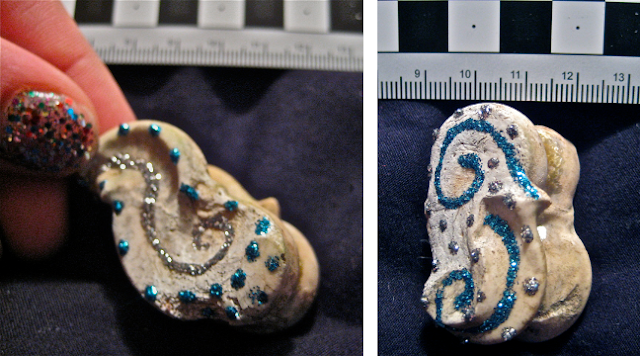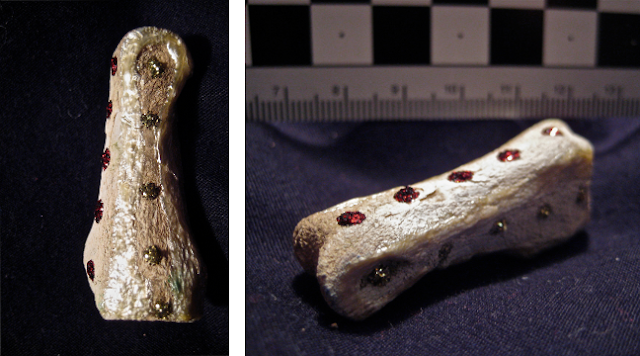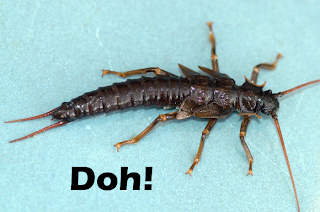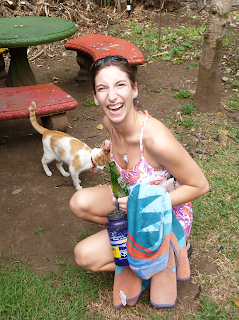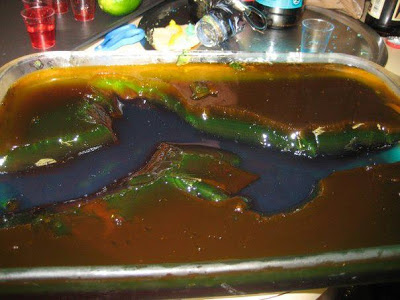Below are Amy's sparkle-drizzled lovelies in all their splendor. Enjoy!
Wednesday, December 26, 2012
PaleoArt: Tinsel Toebone Edition
Life at the Vengeance Team household is always exciting and thrilling, but every once in a while it is punctuated by a moment that rises above the others. Recently, Meaghan entered her house to find the following beauties sitting out on a counter as if someone had ritually sacrificed a My Little Pony to the glitter gods. While she was briefly worried that a BeDazzler-wielding serial killer had left a tribute on her kitchen counter, the array of Mod Podge and Glitter Glue spread around it like a Tunguska event clearly indicated it was just a regular Friday living with Amy.
Below are Amy's sparkle-drizzled lovelies in all their splendor. Enjoy!
Bones were collected during field work in Dillon, Montana and decorated with Stickles and Liquid Pearls line of Rangers glitter glue. Presumed identifications include Marmot (skull and jaw bone) and Mule Deer (Toe and Astragalus).
Below are Amy's sparkle-drizzled lovelies in all their splendor. Enjoy!
Thursday, December 20, 2012
Ugly vs. Snuggly: Pretty Faces Get All The Love (And Money)
Both of these organisms suffer from diminishing habitats as global temperatures rise and the ice melts away. Both of them are the subject of conservation science, but only one of them is the face of Conservation Funding. Can you guess which one?
Sorry Mr. Stonefly, I guess that you hit every ugly branch on your fall along the phylogenetic tree. Maybe it's the feelers, maybe it's the glossy smooth carapace, or maybe it's the fact that that you ditch unwanted exoskeletons on rocks and rafts overnight, scarring Amy on her childhood rafting adventures. Regardless, while the noble polar bear gets funding simply by being fuzzy and well able to hide in a snowstorm, it looks like you're gonna have to go a little further to get some money to unmelt your glaciers. Sure, you're in line to be the first species listed as Endangered due to climate change, but have you considered selling your children to jewelry factories like your less-disgusting cousin the caddisfly? They seem to be doing pretty well for themselves.
| Big pimpin' in the L.A.K.E. |
But honestly, it's not the stonefly's fault. Humans are attracted to giving money to certain things, and top on the list is not anything scaly, slimy, or otherwise crunchy. No, humans tend to appreciate forward-facing eyes, big furry halos, and impressive sizes. When a charity wants to get in on the endangered species money pool, they hit us where it's so cute it hurts, even if the animal they're using doesn't actually make a lot of sense. For example, check out the collection of stuffed animals for sale by the Canadian version of the World Wildlife Fund. Half these animals are actually not "at risk" so much as they are listed by the IUCN Redlist as being of least concern! Perhaps the WWF thinks that the oh-so-gullible Canadians will be fooled by fuzzy faces that aren't endangered; maybe Meaghan's status as a half-breed prevents her from being overwhelmed by adorableness.
This phenomenon is known as using a "Flagship Species" to draw in funding. Genuine research has gone into understanding what draws funding for an animal. Being a mammal is big points in its favor, but if it's an amphibian it's gotta be weird. The conservation of the animal can't be a threat to humans in the area. Being big is a bonus: shrews and possums had better watch their disgusting little steps, because they aren't big enough to warrant public interest. A 2009 study showed that those animals with plenty of research on their conservation status recieved more funding than those without... but that research was typically skewed towards those animals that received more funding: a viciuous, self-feeding cycle that ignored the ugly and small in favor of the big and well-known.
Now to be fair, many charities distribute the funds they receive amongst the less-phenotypically-fortunate organisms, but many don't. In fact, in some cases it seems as though using flagship species actually draws funding away from the organisms that need it the most, as policy is often influenced by the same factors that determine the funding flow in the first place.
What makes an organism or an ecosystem worth saving is a topic for a whole series of other blog posts, but it is the Christmas season: time to donate to the less fortunate, to pay attention to the needy and the less blessed. In the Christmas spirit, Amy and Meaghan have trotted forth several visually-unfortunate animals that are in need of your help. To fund any of the following of Mother Nature's taxonomical Mod Podges, please click on the hyperlink of its name!
| The Aye-Aye on a good hair day. |
The Aye-Aye: The Demon's Woodpecker.
------------------------------------------------------------------------------------
| The tree was shuddering in horror the whole photo shoot. |
The Pangolin is one of the few organisms to be entirely covered in fingernails, which when we started writing this sentence seemed like points in its favor. Um... well, it does mean that the Pangolin is officially the most cost-effective organism at a nail salon - 15$ to get its whole body painted, what a deal! And if crazy, claw-wielding ladies like Flojo can be considered beautiful, then Pangolins must be too.
| Excess keratin is beautiful, guys. |
Unlike Flojo, Pangolins are barred from the Olympics, which is a total shame because they are amazing gymnasts. Baby pangolins cling to their mothers even when Mama Pangolin decides to climb on the ceiling like the girl from the Exorcist. They're like scale-covered burrs! But when you think about amazingly talented and bendy animals you think of primates and Biscuit because despite their incredible climbing ability, pangolins are discriminated against because of their looks. Also possibly because they smell like skunks. But neither skunks nor Flojo can dig straight through cement, now can they?
The Malayan Pangolin: A Fun Hybrid of Animals You Don't Like!
------------------------------------------------------------------------------------
| Tastes like chicken, with a nice sprinkling of volcanic ash and mutating fungus. |
Since the only reason people like to fund amphibians is when they're frickin' weird, we thought we'd pick one that honestly is pretty standard. The most interesting thing about this frog is its name, which is directly related to why it's endangered: it is big and tasty. This frog suffers from a terrible middle ground: it is just delicious enough to eat, but not delicious enough to commercially breed. It also lives in the Caribbean, where its habitat is being restricted by volcanic eruptions. On top of that, this long-time native, first-time endangered frog is afflicted by the chytrid fungus which strikes the dual death blow of killing the frogs and making them even grosser to think about.
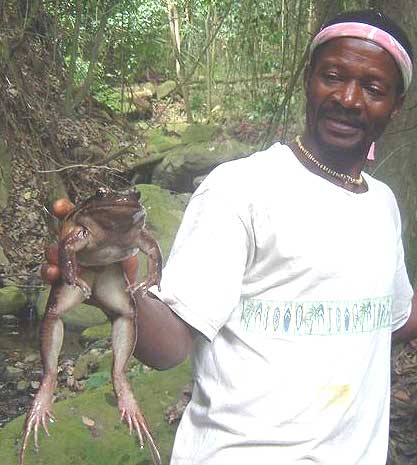 |
| Check out the legs on this one! Mmm mmm delicious. |
The Chicken Frog: Not Quite Tasty Enough To Save.
------------------------------------------------------------------------------------
Sitas, N, J. E Baillie, and N. J Isaac. "What Are We Saving? Developing a Standardized Approach for Conservation Action." Animal Conservation, 12.3 (2009): 231-237.
Smith, Robert, Diogo Verissimo, Nicholas J.B Isaac, and Kate Jones. "Identifying Cinderella Species: Uncovering Mammals with Conservation Flagship Appeal." Conservation Letters, 5.3 (2012): 205-212.
Saturday, December 15, 2012
Optimisim, Travel Style
Costa Rica: home of sloths, monkeys, dishes containing beans and rice, people shoved into clothing so tight they looked like the gently sloping wrinkles of a croissant, exotic new nauseating scents, geckos visible only to Meaghan's eyes, earthquakes, terrifying taxi drivers and hospitals. Many, many hospitals. And over the past week, we've visited some of the best of them!
Let's place you in the shoes of a Costa Rican taxi driver. To get into character, please imagine you understand a complicated language of honking, and that you conceptualize following distance as "I'm not touching their car, and therefore we're cool." Now please imagine you are standing outside the arrivals terminal at the San Jose International Airport, and you see this duo: a small blond girl with a concerned look on her face, and a tall brunette who is pale and sweating like Mike Tyson at a spelling bee. Unfortunately for you, she also has by far the greater Spanish fluency of the two.
"Donde esta la, um, hospito? Hospitalo?" says the blond to you.
"NECISSITO. IR. A. UN. HOSPITAL. POR FAVOR. RAPIDO!" snarls the brunette.
This was the unfortunate way we entered Costa Rica this past week. It was Amy's first trip out of the country, with the exception of about 5 hours she spent in Canada that one time; it was Meaghan's first time visiting a country where she had studied the language at all prior to crossing the border. Was the trip a total disaster? Hell no. Sure, the only sloths and monkeys they saw were the currency the taxi drivers gave them as they drove to and from the Hotel Brilla de Sol and the Clinica San Miguel, but there were some great things too.
So let's break it down into a list of awesome encounters that made this trip great, despite that Amy spent 75% of it trailing an IV bag and smelling faintly of half-chewed fried rice and Costa Rican anesthetic.
For one, this set the bar super, super low for any future travel. Literally, if Amy can arrive at a place without vomiting prior to touching the ground that will be a HUGE WIN.
For two, they survived a damn earthquake! Cuddled together, half-passed out (Amy from Morphine, Meaghan from Amy's overwhelming scent) on a twin bed, they looked up from episode who-knows-how-many of White Collar to find the whole world was gently vibrating them with, as Amy described it, the 'cool attitude of the local people." Of course, Amy was also on a lot of morphine; Meaghan felt more like they were a seal trapped in the jaws of a gigantic killer whale. 4.5, 10 km below the surface... essentially it was a NEAR DEATH EXPERIENCE.
For three, they totally saw some wildlife. There were two genuine Costa Rican Squirrels, which admittedly were a bit more exciting when Meaghan thought they were small monkeys, but they were still pretty cool. Also, there were black vultures: just like regular vultures, but black! Meaghan totally stands by the whole gecko thing, even if they were too shy to hang out with Amy. Finally, there was that one cat. That cat was pretty great - it spoke spanish!
For six, and this one's the big one... Meaghan got to take a Magic School Bus Adventure down Amy's esophagus with the wonder of gastroscopic technology. It was simultaneously the most thrilling and horrifying adventure travel she's ever experienced. Watching the doctor lube up the tip of a gigantic plastic spider arm - we're talking nickel diameter here people, NICKEL DIAMETER - and shove it down her throat was slightly less on the thrilling side for Amy, especially as this served as an excellent opportunity to unexpectedly douse her stomach directly with a frothy horchata* medicine, which they had earlier served her in a snowcone cup... por el dolor. *Amy has repeatedly reassured Meaghan that despite the smell this did not taste anything like horchata, but like the existence of the geckos, Meaghan and Amy will simply have to disagree.

And finally, Amy got the ultimate revenge on a TSA employee. Sure, Meaghan and Amy may have both spent four days in the hospital, and only showered a single time that whole week, but it was worth it when Amy lifted her arms and that poor woman had to go straight for the armpits on the patdown. That one was for America, everyone, that one was for America.
But really, guys, it wasn't that bad. We're gonna go again, the worst has already happened, and as a bonus it turns out there's this place to tide us over. Next time we go to Costa Rica, we'll have plenty of practice cuddling sloths. We will be sloth cuddling experts. We'll have put it on our resumes, embossed it on our business cards, and created decals for our vehicles: that's how totally pro at sloth snugglin' we're gonna be by the next time we go to Costa Rica.
We're sure the Costa Rican sloths can't wait.
Let's place you in the shoes of a Costa Rican taxi driver. To get into character, please imagine you understand a complicated language of honking, and that you conceptualize following distance as "I'm not touching their car, and therefore we're cool." Now please imagine you are standing outside the arrivals terminal at the San Jose International Airport, and you see this duo: a small blond girl with a concerned look on her face, and a tall brunette who is pale and sweating like Mike Tyson at a spelling bee. Unfortunately for you, she also has by far the greater Spanish fluency of the two.
"Donde esta la, um, hospito? Hospitalo?" says the blond to you.
"NECISSITO. IR. A. UN. HOSPITAL. POR FAVOR. RAPIDO!" snarls the brunette.
The taxi driver was eager to drop us off here.
This was the unfortunate way we entered Costa Rica this past week. It was Amy's first trip out of the country, with the exception of about 5 hours she spent in Canada that one time; it was Meaghan's first time visiting a country where she had studied the language at all prior to crossing the border. Was the trip a total disaster? Hell no. Sure, the only sloths and monkeys they saw were the currency the taxi drivers gave them as they drove to and from the Hotel Brilla de Sol and the Clinica San Miguel, but there were some great things too.
So cute, but not so cuddly.
So let's break it down into a list of awesome encounters that made this trip great, despite that Amy spent 75% of it trailing an IV bag and smelling faintly of half-chewed fried rice and Costa Rican anesthetic.
For one, this set the bar super, super low for any future travel. Literally, if Amy can arrive at a place without vomiting prior to touching the ground that will be a HUGE WIN.
For two, they survived a damn earthquake! Cuddled together, half-passed out (Amy from Morphine, Meaghan from Amy's overwhelming scent) on a twin bed, they looked up from episode who-knows-how-many of White Collar to find the whole world was gently vibrating them with, as Amy described it, the 'cool attitude of the local people." Of course, Amy was also on a lot of morphine; Meaghan felt more like they were a seal trapped in the jaws of a gigantic killer whale. 4.5, 10 km below the surface... essentially it was a NEAR DEATH EXPERIENCE.
For three, they totally saw some wildlife. There were two genuine Costa Rican Squirrels, which admittedly were a bit more exciting when Meaghan thought they were small monkeys, but they were still pretty cool. Also, there were black vultures: just like regular vultures, but black! Meaghan totally stands by the whole gecko thing, even if they were too shy to hang out with Amy. Finally, there was that one cat. That cat was pretty great - it spoke spanish!
"I said Hola Gato and he came right over!"
For four, the people there are incredible. The manager of the hotel we stayed at was very kind, and very worried about us every time we had to return to the hospital. The secretary who spoke fluent English made sure to stay in contact with our doctors even when she was off shift, acting as translator via text. There was also that lady whose job wasn't clear, but who made certain to soothingly pet Amy's head and whisper "Shh, shh, tranquilla, tranquilla" for long hours late into the morning. The doctors were all (astoundingly) horrified that after four days in the hospital we were considering leaving the country, and insisted that upon our return we come visit them again; apparently one of them has a surfing sister who lives at the beach, and a cousin in the mountains, and we are welcome to stay with any of them.
Look at where we spent our vacation! Nice, eh?
For five, the standard of medical care was amazing. They treated Amy's pain quickly and efficiently, communicated well despite an extensive language barrier, and provided amazing care throughout the whole ordeal. Everyone we encountered was incredibly kind and helpful, and we couldn't have been better cared for. For many people, the idea of being stranded in a foreign country during a medical emergency is terrifying, but Amy and Meaghan want to point out that with every visit Amy was in a room with an IV and pain treatment within 20 minutes. Compare this to an Emergency Room in America, where you can wait several hours before seeing a doctor, let alone having your pain dealt with... and in Costa Rica, four days in and out of the hospital cost about a 20th of an American hospital.
Plus Meaghan and Amy got to catch up on White Collar...
For six, and this one's the big one... Meaghan got to take a Magic School Bus Adventure down Amy's esophagus with the wonder of gastroscopic technology. It was simultaneously the most thrilling and horrifying adventure travel she's ever experienced. Watching the doctor lube up the tip of a gigantic plastic spider arm - we're talking nickel diameter here people, NICKEL DIAMETER - and shove it down her throat was slightly less on the thrilling side for Amy, especially as this served as an excellent opportunity to unexpectedly douse her stomach directly with a frothy horchata* medicine, which they had earlier served her in a snowcone cup... por el dolor. *Amy has repeatedly reassured Meaghan that despite the smell this did not taste anything like horchata, but like the existence of the geckos, Meaghan and Amy will simply have to disagree.
Re-enactment of Meaghan's role during the Gastroscopia, which was to stare in horror at the camera images and click the photo button whenever the doctor said "FOTO!" which was hard to hear over the sound of Amy's delicate and graceful* retching. *Meaghan and Amy also degree on adjective use here.
For seven, Amy got to see her name spelled like this on an official document!

Please note that Amy's parents named both her and her brother
with simplicity in mind, to prevent unfortunate nicknames. FAIL.
with simplicity in mind, to prevent unfortunate nicknames. FAIL.
Amy even learned how to de-clot her own IV!
But really, guys, it wasn't that bad. We're gonna go again, the worst has already happened, and as a bonus it turns out there's this place to tide us over. Next time we go to Costa Rica, we'll have plenty of practice cuddling sloths. We will be sloth cuddling experts. We'll have put it on our resumes, embossed it on our business cards, and created decals for our vehicles: that's how totally pro at sloth snugglin' we're gonna be by the next time we go to Costa Rica.
We're sure the Costa Rican sloths can't wait.
Sunday, December 2, 2012
PaleoArt Jello Shots Edition
In addition to being scientists, world travelers, philanthropists in very limited senses, and generally awesome, Meaghan and Amy are also paleoartists. Here are some recent works of brilliance, cast in alcoholic jello.
| Diving Cladoselache |
| Indarctos oregonensis in tar pit |
| Stegosaurus demonstrating low buoyancy typical of pneumaticity-lacking ornithischians |
| Chondrichthyes in lava |
Subscribe to:
Posts (Atom)



